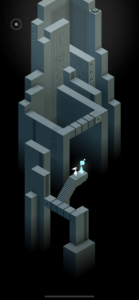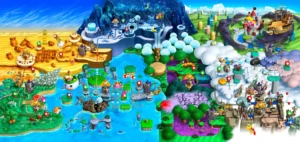Background:
Monument Valley has always been a game I have been familiar with, as the recipient of many awards for design and aesthetics, and I was extremely thrilled for this opportunity to not only finally take time to play the game, but also analyze its elements. Monument Valley was made in 2014 by ustwo games and has been recognized/acclaimed over the near-decade since its launch, winning the Apple Design Award, Apple Game of the Year, GDC Innovation Award, etc. This visual masterpiece and physics-defying puzzle game is playable on iOS, Android, and Windows. Having played the game, Monument Valley seems to cater to puzzle lovers, 2D/3D design fanatics, and casual gamers. The difficulty of the puzzles/illusions are not audience-limiting (the game lists a 4+ age demographic), and the simple mechanics of tap to control/pull down make it playable to nearly anyone. However, the design elements of the game (puzzle and deception design and aesthetics) definitely cater towards fans of those domains, but can be appreciated by all.
Formal Elements:
Monument Valley follows the protagonist (Princess Ida) through various levels of world puzzles. Each level is an expertly crafted, intricate puzzle that defies physics and spatial expectations. Throughout each level, the game goal is to complete the puzzle and guide the Princess through mysterious monuments, uncover hidden paths, and unfold optical illusions until she reaches a clearly defined end goal. After successful completion of a level, there are beautiful animations that unlock the following levels. Players are able to complete each level by tapping on parts of the map to control the princess’s walking and rearrange the terrain around her to unlock new, unexpected routes.

Types of Fun
Monument Valley leverages discovery and challenge as its two primary types of fun. The exploration of the various landscapes with each new level is fun. Further, with each couple of new levels, the player is introduced to a new mechanic of how they can alter the world to develop new paths), which heightens the sense of discovery. This is similarly leveraged in challenge, with each level comes increased difficulty/length of the puzzle but also the player has access to more world-alternating knowledge and capability.
Mechanics
Having played the game, I found that there are two they gameplay mechanics that help produce these types of fun:
- Physics Defying Worlds
-
-
- The function of the game is inspired by the famous stair illusions where depth is not clearly defined. The ability for players to change the monument architecture, spin wheels to allows certain paths to reach others, and rotate the princess’s perspective allows for a combination of challenge and discovery/creative problem solving.
-
- Use of Physical Clues/Hints
-
-
- The hint mechanic in this game is not explicitly told, but instead there are visual indicators on various walls and parts of the monument architecture that players are trained to notice over time.
-
These various mechanics help the game reach its goal of inciting challenge and discovery, but also maintaining beautiful aesthetics. The minimalist approach of the hint mechanic (by embedding it in the physical architecture and not having clunky text boxes) and the physics-defying world that allows for beautiful world design, work to achieve the game’s overarching goal.
Game Improvements:
Having played the game for over an hour, I found that the narrative of the game was lacking. The puzzle and level dynamic of the game allows for the player to step in and out of this world with leisure and ease. For a game designer, that is ideal. The game easily adapts to quick plays (bus rides, for example). However the lack of strong plot does make the overarching narrative not completely gripping. The most exciting part of the game is unlocking the expanded visual worlds and further visuals, rather than finding out more information about the plot. I believe the game could be expanded by a more interactive plot and more engagement in world building (think Super Mario Bros). How the Super Mario Bro game play works involves navigating through different parts of a world/map that all feel independent.

Here, we can visually see all the different worlds and visually feel that sense of narrative/accomplishment/progress. By nature of being a mobile game, a highly-demanding plot may detract from the quick-play model. However, a simple map may help remedy this case.



